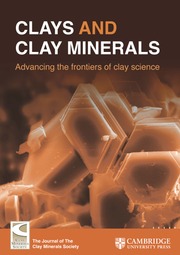Article contents
A Solid-Solution Model for Fe(II)-Fe(III)-Mg(II) Green Rusts and Fougerite and Estimation of their Gibbs Free Energies of Formation
Published online by Cambridge University Press: 01 January 2024
Abstract
Fe(II)–Fe(III) green rust identified in soil as a natural mineral is responsible for the blue-green color of gley horizons, and exerts the main control on Fe dynamics. A previous EXAFS study of the structure of the mineral confirmed that the mineral belongs to the group of green rusts (GR), but showed that there is a partial substitution of Fe(II) by Mg(II), which leads to the general formula of the mineral: [Fe1−x2+Fex3+Mgy(OH)2+2y]x+[xOH−⋅mH2O]x−${[{\rm{Fe}}_{1 - x}^{2 + }{\rm{Fe}}_x^{3 + }{\rm{M}}{{\rm{g}}_y}{({\rm{OH}})_{2 + 2y}}]^{x + }}{[x{\rm{O}}{{\rm{H}}^ - } \cdot m{{\rm{H}}_2}{\rm{O}}]^{x - }}$ . The regular binary solid-solution model proposed previously must be extended to ternary, with provision for incorporation of Mg in the mineral. Assuming ideal substitution between Mg(II) and Fe(II), the chemical potential of any Fe(II)-Fe(III)-Mg(II) hydroxy-hydroxide is obtained as: μ=X1μ1o+X2μ2o+X3μ3o+RT[X1lnX1+X2lnX2+X3lnX3]+A12X2(1−X2)${\rm{\mu }} = {X_1}{\rm{\mu }}_{\rm{1}}^{\rm{o}} + {X_2}{\rm{\mu }}_{\rm{2}}^{\rm{o}} + {X_3}{\rm{\mu }}_{\rm{3}}^{\rm{o}} + {\rm{R}}T[{X_1}{\rm{ln}}{X_1} + {X_2}{\rm{ln}}{X_2} + {X_3}{\rm{ln}}{X_3}] + {A_{12}}{X_2}(1 - {X_2})$
. The regular binary solid-solution model proposed previously must be extended to ternary, with provision for incorporation of Mg in the mineral. Assuming ideal substitution between Mg(II) and Fe(II), the chemical potential of any Fe(II)-Fe(III)-Mg(II) hydroxy-hydroxide is obtained as: μ=X1μ1o+X2μ2o+X3μ3o+RT[X1lnX1+X2lnX2+X3lnX3]+A12X2(1−X2)${\rm{\mu }} = {X_1}{\rm{\mu }}_{\rm{1}}^{\rm{o}} + {X_2}{\rm{\mu }}_{\rm{2}}^{\rm{o}} + {X_3}{\rm{\mu }}_{\rm{3}}^{\rm{o}} + {\rm{R}}T[{X_1}{\rm{ln}}{X_1} + {X_2}{\rm{ln}}{X_2} + {X_3}{\rm{ln}}{X_3}] + {A_{12}}{X_2}(1 - {X_2})$ . All experimental data show that the mole ratio X2 = Fe(III)/[Fetotal + Mg] is constrained (1) structurally and (2) geochemically. Structurally, Fe(III) ions cannot neighbor each other, which leads to the inequality X2α13.${X_2}\leqslant {\raise0.5ex\hbox{$\scriptstyle 1$}\kern-0.1em/\kern-0.15em\lower0.25ex\hbox{$\scriptstyle 3$}}.$
. All experimental data show that the mole ratio X2 = Fe(III)/[Fetotal + Mg] is constrained (1) structurally and (2) geochemically. Structurally, Fe(III) ions cannot neighbor each other, which leads to the inequality X2α13.${X_2}\leqslant {\raise0.5ex\hbox{$\scriptstyle 1$}\kern-0.1em/\kern-0.15em\lower0.25ex\hbox{$\scriptstyle 3$}}.$ Geochemically, Fe(III) cannot be too remote from each other for GR to form as Fe(OH)2 and Mg(OH)2 are very soluble, so X2α14${X_2}\geqslant {\raise0.5ex\hbox{$\scriptstyle 1$}\kern-0.1em/\kern-0.15em\lower0.25ex\hbox{$\scriptstyle 4$}}$
Geochemically, Fe(III) cannot be too remote from each other for GR to form as Fe(OH)2 and Mg(OH)2 are very soluble, so X2α14${X_2}\geqslant {\raise0.5ex\hbox{$\scriptstyle 1$}\kern-0.1em/\kern-0.15em\lower0.25ex\hbox{$\scriptstyle 4$}}$ . A linear relationship is obtained between the Gibbs free energy of formation of GR, normalized to one Fe atom, and the electronegativity ϰ of the interlayer anion, as: μo/n = −76.887ϰ — 491.5206 (r2 = 0.9985, N = 4), from which the chemical potential of the mineral fougerite μ is obtained in the limiting case X3 = 0, and knowing μ1o=−489.8${\rm{\mu }}_{\rm{1}}^{\rm{o}} = - 489.8$
. A linear relationship is obtained between the Gibbs free energy of formation of GR, normalized to one Fe atom, and the electronegativity ϰ of the interlayer anion, as: μo/n = −76.887ϰ — 491.5206 (r2 = 0.9985, N = 4), from which the chemical potential of the mineral fougerite μ is obtained in the limiting case X3 = 0, and knowing μ1o=−489.8${\rm{\mu }}_{\rm{1}}^{\rm{o}} = - 489.8$ kJmol−1 for Fe(OH)2, and μ3o=−832.16${\rm{\mu }}_{\rm{3}}^{\rm{o}} = - 832.16$
kJmol−1 for Fe(OH)2, and μ3o=−832.16${\rm{\mu }}_{\rm{3}}^{\rm{o}} = - 832.16$ kJmol−1 for Mg(OH)2, the two unknown thermodynamic parameters of the solid-solution model are determined as
kJmol−1 for Mg(OH)2, the two unknown thermodynamic parameters of the solid-solution model are determined as
μ2o=+119.18kJmol−1${\rm{\mu }}_{\rm{2}}^{\rm{o}} = + 119.18\;{\rm{kJmo}}{{\rm{l}}^{ - 1}}$ for Fe(OH)3 (virtual), and A12 = −1456.28 kJmol−1 (non-ideality parameter). From Mössbauer in situ measurements and our model, the chemical composition of the GR mineral is constrained into a narrow range and the soil solutions-mineral equilibria computed. Soil solutions appear to be largely overstaurated with respect to the two forms observed.
for Fe(OH)3 (virtual), and A12 = −1456.28 kJmol−1 (non-ideality parameter). From Mössbauer in situ measurements and our model, the chemical composition of the GR mineral is constrained into a narrow range and the soil solutions-mineral equilibria computed. Soil solutions appear to be largely overstaurated with respect to the two forms observed.
Information
- Type
- Research Article
- Information
- Copyright
- Copyright © 2004, The Clay Minerals Society
References
- 33
- Cited by

